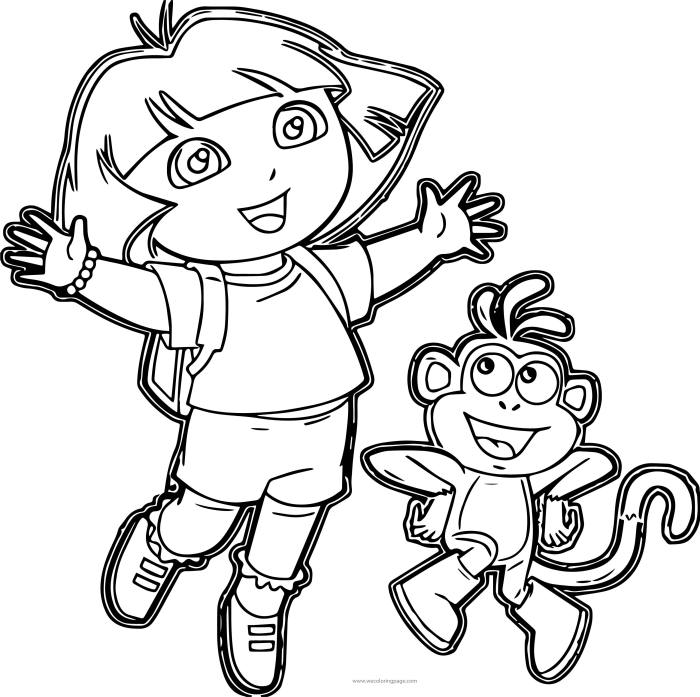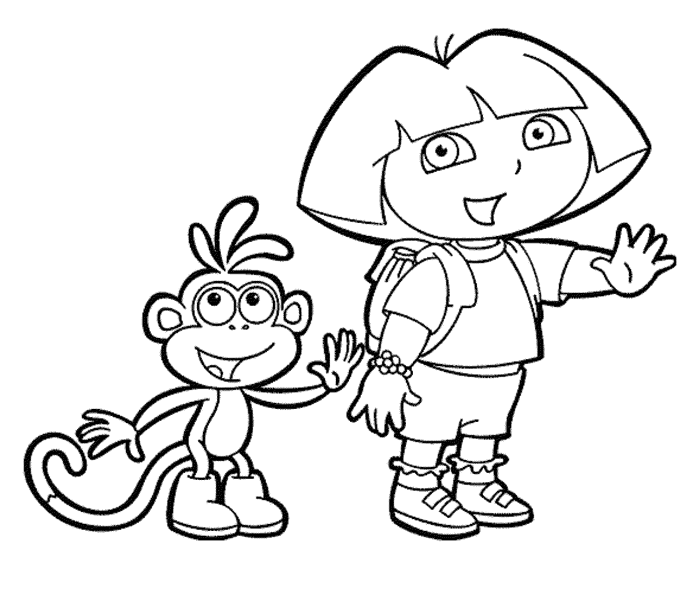Market Analysis of “Dora the Explorer Coloring Book”

Dora the explorer coloring book – The Dora the Explorer brand enjoys significant recognition and popularity among preschool-aged children and their parents. A coloring book featuring Dora and her friends presents a strong opportunity within the competitive children’s entertainment market, capitalizing on existing brand loyalty and the enduring appeal of coloring activities for young children.
Target Audience
The primary target audience for a Dora the Explorer coloring book is children aged 3-6 years old. This age group is developmentally ready for fine motor skill activities like coloring, and Dora’s vibrant personality and adventurous storylines resonate strongly with their interests. Secondary audiences include parents and caregivers who purchase the books for their children, as well as preschools and childcare facilities seeking engaging educational materials.
The book’s design should consider the age range, using bright colors, simple images, and potentially larger spaces for coloring to accommodate younger children’s motor skills.
Key Competitors and Pricing Strategies
Three key competitors in the children’s coloring book market include Disney, Crayola, and Nickelodeon (excluding Dora). Disney coloring books, often featuring popular characters like Mickey Mouse and princesses, typically range in price from $4 to $8, depending on the size and number of pages. Crayola coloring books, focusing more on creative activities and less on specific characters, generally fall within a similar price range.
Nickelodeon’s coloring books, featuring characters from various shows, often have a comparable price point to Disney’s offerings. This indicates a competitive landscape where pricing is largely consistent across major players.
Successful Marketing Campaigns for Similar Products
Successful marketing campaigns for similar children’s products often leverage a multi-platform approach. For example, the launch of a new Disney movie often includes a coordinated release of related coloring books, promoted through television advertisements during children’s programming, online advertising targeting parents, and in-store displays at major retailers. Social media marketing, particularly on platforms like Instagram and Facebook, is also frequently used to showcase the coloring book, engage with parents, and run contests or giveaways.
These campaigns often emphasize the educational and fun aspects of the product, highlighting its ability to foster creativity and imaginative play.
Potential Distribution Channels
Distribution channels for a Dora the Explorer coloring book should encompass a wide reach to maximize sales. Major retailers such as Walmart, Target, and Amazon are essential for broad market penetration. Specialty toy stores and bookstores can also provide valuable sales opportunities. Furthermore, online marketplaces like Etsy can cater to niche markets or collectors. Licensing agreements with fast-food chains or other businesses could also lead to promotional distribution, including offering the coloring book as a meal deal add-on or giveaway.
Direct-to-consumer sales through the Nickelodeon website or a dedicated online store are additional options to explore.
Dora the Explorer coloring books offer a vibrant world of adventure for young artists. For those seeking a slightly more action-packed experience, however, consider the exciting illustrations found in the power rangers coloring book ; it’s a great alternative for kids who enjoy a bit more dynamism. Returning to Dora, her playful designs remain a classic choice for fostering creativity and a love of coloring.
Additional Features and Enhancements

Enhancing the Dora the Explorer coloring book beyond simply providing coloring pages can significantly boost its appeal and market value. Adding bonus content, carefully selecting paper quality, and exploring licensing opportunities are key strategies for achieving this.
Bonus Content Inclusion
The inclusion of bonus content can transform the coloring book from a single-use item into a more engaging and valuable product. Consideration should be given to the target audience – young children – when selecting the type of bonus content. For example, a sheet of stickers featuring Dora, Boots, and other familiar characters would be a popular addition.
Simple, age-appropriate games, like a connect-the-dots activity or a simple maze featuring Dora’s world, could also enhance the experience. Interactive elements, while more complex to implement, could include augmented reality (AR) features accessible via a smartphone app, bringing the coloring pages to life. This could involve unlocking animations or sounds when a specific page is scanned. However, the simplicity of the core coloring book should not be compromised.
Paper Type Selection
The choice of paper significantly impacts the user experience. Thicker paper, such as at least 100gsm, prevents bleed-through from markers or crayons, a crucial factor for young children who often apply significant pressure. A slightly textured paper can also enhance the coloring experience, providing a more satisfying feel and potentially improving the vibrancy of the colors. Conversely, thinner paper, while more economical, is likely to result in frustration due to bleed-through, negatively affecting the overall product quality and potentially leading to dissatisfied customers.
Consideration should also be given to the environmental impact, with options such as recycled paper being a potential sustainable alternative. The paper should be bright white or off-white to provide a clean background for the coloring.
Licensing Opportunities
Expanding the Dora the Explorer brand through licensing provides multiple avenues for growth. Three potential opportunities include:
- Partnership with Crayola or a similar brand: A co-branded coloring book featuring Crayola crayons or markers would leverage the established reputation of a leading art supply company, increasing the product’s perceived value and appeal to parents. This would also offer opportunities for cross-promotional activities.
- Development of related merchandise: The success of the coloring book could be leveraged to create complementary products, such as Dora-themed activity books, sticker books, or even small toys that could be bundled with the coloring book as a special edition. This would extend the product’s lifespan and generate additional revenue streams.
- Collaboration with a children’s apparel company: A licensing agreement with a children’s clothing brand could lead to the creation of Dora-themed clothing items featuring designs inspired by the coloring book. This would create a synergistic marketing opportunity, promoting both the coloring book and the apparel line to a shared target audience.
Product Packaging Mock-up
The packaging will be a vibrant, eye-catching design featuring Dora and Boots prominently displayed. The color scheme will be consistent with the established Dora the Explorer branding, using bright, cheerful colors. The front will showcase a selection of images from the coloring book’s interior, giving potential buyers a preview of the content. The back will include a brief description of the book’s features, including the bonus content, the type of paper used, and age appropriateness.
Important information such as the publisher’s logo, barcode, and recommended retail price will be clearly visible. The packaging will be made from recyclable materials, aligning with environmentally conscious practices. The overall design aims to be both visually appealing and informative, attracting attention on store shelves and providing parents with the necessary information to make an informed purchase. The dimensions will be appropriate for retail shelving and shipping.
Pricing and Production

This section details the pricing strategy, production methods, cost breakdown, and vendor selection process for the “Dora the Explorer” coloring book. A successful launch requires careful consideration of these factors to ensure profitability and high-quality output. We will examine various printing options and estimate costs to arrive at a competitive price point while maintaining a desirable profit margin.
Competitive Pricing Strategy
The pricing strategy will be based on a competitive analysis of similar children’s coloring books currently available in the market. We will consider factors such as page count, size, paper quality, and the inclusion of additional features (e.g., stickers, crayons). A price slightly below the average of competitors, but still reflecting the quality of our product, will be considered to achieve a strong market position.
A premium price might be justified if unique features significantly enhance the value proposition. For example, a coloring book with superior paper quality and unique Dora-themed designs might command a higher price. We will also analyze the price elasticity of demand for coloring books within the target demographic to inform our final pricing decision. This involves understanding how much the demand for the book changes in response to changes in its price.
Printing Method Comparison
Three printing methods will be evaluated: offset printing, digital printing, and screen printing.Offset printing is cost-effective for large print runs (e.g., 10,000+ copies), offering high-quality results with vibrant colors and sharp images. However, setup costs are relatively high. Digital printing is suitable for smaller print runs, offering flexibility and faster turnaround times, but at a higher per-unit cost compared to offset printing.
The quality is generally good, though potentially not as high as offset. Screen printing, best for simpler designs, is ideal for small-scale production or specialized effects (e.g., textured paper). However, it’s generally less cost-effective for large-scale production of a full-color coloring book. Considering the expected sales volume, offset printing is likely the most cost-effective option for this project.
Estimated Production Costs, Dora the explorer coloring book
The estimated production costs are broken down as follows:
| Cost Item | Estimated Cost per Unit | Notes |
|---|---|---|
| Paper (80lb gloss) | $0.20 | Cost varies based on paper quality and quantity purchased. |
| Ink | $0.10 | Dependent on the number of colors used. |
| Printing (Offset) | $0.50 | Cost varies depending on print run size and vendor. |
| Binding | $0.10 | Saddle stitch binding assumed. |
| Packaging (Cardboard sleeve) | $0.15 | Cost can be adjusted based on packaging design. |
| Design and Artwork | $500 (fixed) | One-time cost for design and illustration. |
| Total Cost per Unit | $1.05 | Excluding design and artwork amortization across print run. |
Note: These are estimated costs and may vary depending on the final design, vendor selection, and print run size. Amortizing the design and artwork cost across a 10,000 unit print run adds $0.05 per unit.
Printing Vendor Selection
Selecting a suitable printing vendor involves considering several key factors: capacity to handle the print run size, quality of printing and color reproduction, turnaround time, and price. We will request quotes from multiple vendors, comparing their offerings based on these factors. References and reviews will be checked to assess reliability and past performance. The chosen vendor should have a proven track record of delivering high-quality work within the required timeframe and budget.
We will also consider vendors with certifications that ensure environmental sustainability and ethical labor practices.
